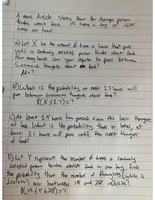Problem #1 -- The fact that it says "the average person" tells me the article is written poorly and not well thought out.
Problem #2 -- Are we to assume that the Daily Rate is perfectly scalable to an Hourly Rate? If we're talking about humans, that is preposterous. One may wish to include at least 6 hours of sleep.
Problem #3 -- Assuming that the "15 times a day" information is from a decent survey, the very idea that we should apply a population average to a single individual is a rookie error. We should not EVER think that way. You are selecting a sample of one (1)! What's the probability that the selected person acts anything like the population average? You want to talk about the average response of the population, NOT a single individual.
If you want to, you can write part C as P(X>3.1|X>1.5).
Problem #4 -- You could run the text past just one English Major. That would improve the parallelism problem quite a bit.
Having said that, lets see if you can follow the continuous part of the problem.
Define thinking of food as a Failure, we can talk about the Mean Time Between Failures. I'll ignore the sleeping, but you should consider it.
The failure rate, then is 15/24 - 15 failures in 24 hours. Because we're looking at a 24 hour period, let's use [math]\omega = 24[/math], the maximum value we can get out of a day.
Check to see that we have a proper probability distribution: [math]\int_{0}^{24}\dfrac{15}{24}\cdot e^{-t(15/24)} = 1[/math]. It's not REALLY unity, but it's pretty close.
The mean time, then, is given by the mean of this distribution. [math]E[t] = \int_{0}^{24}\dfrac{15}{24}\cdot t\cdot e^{-t(15/24)} = 1.6, \;this\; is\;your\;\mu[/math].
P(X<1.7) is pretty simple, now: [math]\int_{0}^{1.7}\dfrac{15}{24}\cdot e^{-t(15/24)} = 0.654409[/math], thereabouts.
The next one is a little more fun: P(X>3.1|X>1.5) = [math]\dfrac{\int_{3.1}^{24}\dfrac{15}{24}\cdot e^{-t(15/24)}}{\int_{1.5}^{24}\dfrac{15}{24}\cdot e^{-t(15/24)}} = \dfrac{0.144063}{0.391605} = 0.3679[/math]
That's enough. I'll leave the last one for you and let you add up a bunch of Poisson probabilities. I gave you as much as I did because I thought maybe I owed it to you after telling how how bad is the whole conception of the problem statement.
Note: There is only one variable, t, thus for the sake of visual clarity, I omitted all the little "dt" symbols. As there is no ambiguity, this is not a problem. If you had a calculus professor who insisted that there is or has been only one authoritative notation for such things, you have not been told the truth. On the other hand, if your teacher insists or you'll get a test problem wrong, you should probably put them in. And, yes, it would have been easier to put them in than it was to write this disclaimer.


